A good friend of mine recently purchased a new DI box; an Orchid Electronics Direct Inject box – an active DI that retails for about 40 quid. It looks like this:
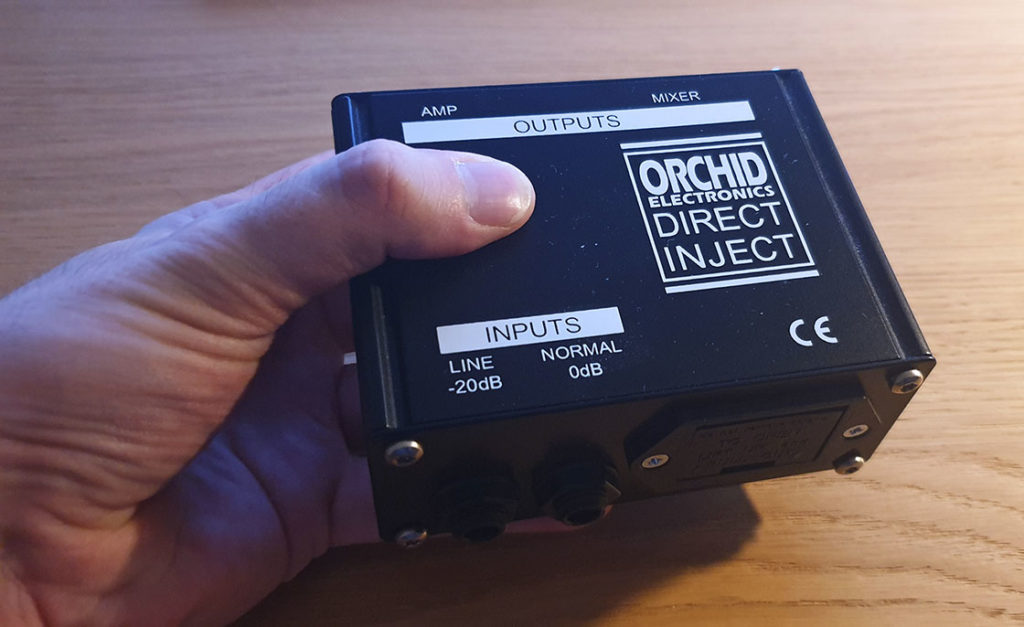
He excitedly proclaimed that for the money the sound was fantastic, enjoying in particular how it interfaced with his bass guitar. I was intrigued.
At this point I was forced to confess a guilty little secret; I never really got DI boxes. I mean… they balance the signal, right? And they bump up the level… great for giving a leg up to weak signals over long distances… and… that’s… basically it. Isn’t it? Some have bells, others have whistles – pad switches, ground lift toggles, active, passive, etc, etc, but the idea that this little thing can be expected to do anything magical to the sound was never something that made sense to me when faced with that kind of claim. In my studio I had always used a Behringer DI800 unit, or whatever other small, inexpensive DI box I happened to have lying around, and that always seemed to accomplish the task that was being asked of it; get a signal from here to there without adding unwanted noise. But I had never directly compared any two, so what do I know?
While absently Googling different DI boxes and their specs I found this page on gearank.com (dangerously close to gearwank.com..??), which contains sentences such as:
“Countryman Type 85 – Everything from acoustic guitars, to Telecasters, to bass guitars, and even old electric pianos have been plugged into this DI with satisfactory results. Most agree that they can hear the nuances of their playing style and instrument better when using this humble DI Box.
Behringer Ultra-DI DI600P – Understandably, those who have more expensive DI Boxes will find the sound of the DI600P lacking, but for the average band performance and home recording enthusiast, it gets the job done efficiently.
Radial ProDI – it is reassuring that professionals like Terry Lawless (plays keyboards for U2!) endorse this unit… From keyboards to laptops, and even instruments, the ProDI will get you sounding good without much hassle.”
Blimey. There’s more to this DI lark than I thought. Either that or these sentences were written by someone simply scouring the internet for any old bullshit to say in an attempt to differentiate superficially different devices about which they know fuck all.
Maybe both.
A more pleasingly technical look at the DI box comes from the direction of Sound On Sound’s Hugh Robjohns, who, in this article, writes:
“The main reason most DI boxes employ an output transformer is to provide electrical isolation between the source and destination equipment. As well as preventing ground loops, this offers protection against faults in equipment on one side of the DI box damaging that connected to the other, though whether all DI boxes employ transformers with a sufficient safety rating to guarantee that isolation is another matter! Cheap transformers usually introduce significant amounts of harmonic distortion and struggle with low frequencies and high levels, but a good quality, low-distortion, electrically safe transformer is inherently expensive. If a DI box is being used with a fuzz guitar these things are perhaps less important… but they can stand out like sore thumbs when used with a good acoustic guitar, for example…
…In situations where the equipment connected to these DI boxes is known to be well maintained I’d have no qualms at all about the absent output transformer, but there are a couple of situations where the transformerless boxes may prove inferior to more conventional transformer-coupled designs such as the Radial. The first is when connecting the output of a laptop or computer interface to a mixing console or recorder, as computer ground-noise is more likely to become audible as nasty buzzes and whines. The other is when connecting equipment of unknown condition or connecting to equipment powered separately in an OB truck or separate building. In these cases the galvanic isolation of a proper isolating transformer can, quite literally, be a life-saver.”
This is a bit more like it – information that is actually useful. Less conjectural bullshit about “sound character”, and more technical justification of the kind of thing we should really be looking out for in a good DI box.
Anyway, for my own part, I decided to use this circumstance as an opportunity to do some comparisons of my own. Far from being motivated (yet) to run tests comprehensive enough to discuss the differences between a range of different DI boxes under different conditions with any degree of certainty, I at least wanted to see if there was any truth to my friend’s claim that his Orchid DI “sounded great”, particularly when compared to a Behringer Ultra-DI that was to hand. Indeed he seemed to think that his box had just a little extra something that stepped up his bass tone. I, on the other hand, remained skeptical.
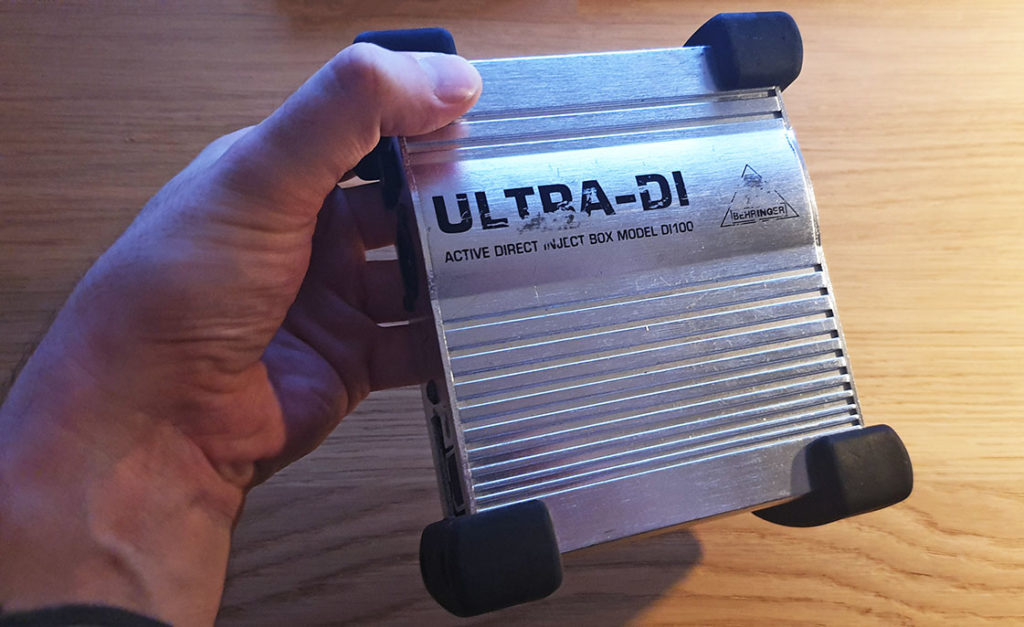
And so I took both devices and got to work. I wanted to see what all the fuss was about, so I plugged in an electric guitar to each DI box, which was in turn connected to my M-Audio home interface, powered with phantom power, and quite literally recorded the results.
The first thing to notice was the differing amount of gain applied to each signal. Larger than I had expected. I put down my guitar and used a 440Hz test tone to measure this:
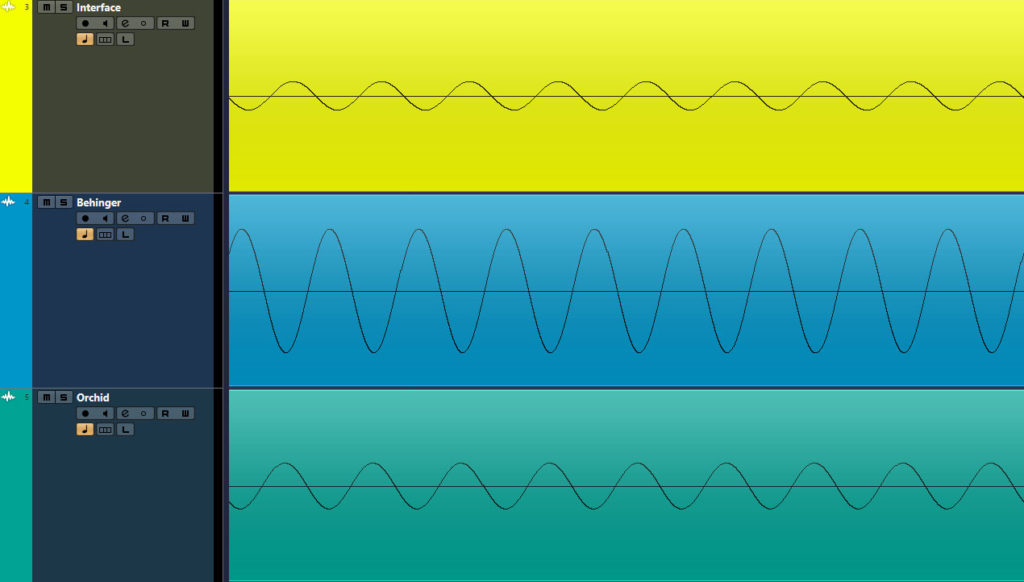
The results were as follows:
- No DI box (signal patched from output straight to input): -16.4dB
- Behringer Ultra-DI: -3.7dB
- Orchid Direct Inject: -12.4dB
Straight off the bat we see that the Behringer provides 12.7dB of gain, while the Orchid provides only 4dB. Combined with the Behringer’s two -20dB pad switches, vs Orchid’s single -20dB alt input, the Behringer is the winner in terms of providing a higher output with less faff yet more control.
Armed with this information, I recorded a straightforward guitar line, badly played and slightly out of tune through both devices, one after the other, and then gain matched as appropriate after the fact. Here are the results (I recommend downloading the files and comparing in a DAW):
Behringer Ultra-DI – Electric Guitar
Orchid Direct Inject – Electric Guitar
On review, I find it (as usual) impossible to glean much useful information from a test such as this because of its lack of scientific accuracy. Testing a different performance through two different devices has all sorts of flaws, not least that the performances are by definition, different. I can easily convince myself that I hear important differences in one over the other, but given that it’s very possible that any number of variables could be affecting my performance in either case (strum velocity, playing position, temperature, unexpected bowel movement, etc, etc), it’s impossible to make any objective claim one way or the other. All I can say is that they sound very similar indeed, and the extent to which they don’t is both tiresomely subtle and impossible to account for.
I decided instead to try something more scientifically agreeable, so I played a pre-recorded guitar part out an output of my interface and then recorded it back in, first with nothing else in the chain, then with the Behringer DI, and finally with the Orchid DI. This would also have the advantage of providing a more harmonically dense source signal as the basis for my comparison. Here are the results, subsequently gain matched:
No DI – Distorted Guitar
Behringer Ultra-DI – Distorted Guitar
Orchid Direct Inject – Distorted Guitar
Now, I don’t know about you, but I’m not so very sure I can tell these recordings apart.
Still though, perhaps a more accurate approach to take here is to perform a null test, whereby two of these files are superimposed on top of each other, the polarity of one inverted, and the resultant audio inspected. The more they cancel, the more identical they are. However, such a test is littered with pitfalls, given that it invokes more variables than the DI box itself, such as the mic pre, interface and recording algorithms with their quantisation errors, plus the complications arising from the difference in output level of each device. If we do have audio to inspect after a null test, it’s impossible to know what to blame it on. Still, ever the curious fellow, I tried it anyway:
Null Test – Original vs No DI (signal patched from output straight to input)
Null Test – Original vs Behringer
Null Test – Original vs Orchid
So it’s firstly worth pointing out that performing a null test with no DI box at all does not lead to complete cancellation, hence we have some grounds to be uncertain of our findings when a DI box is inserted in the chain. However we do find that there appears to be a difference between the two DIs when compared to the original recording. Crudely summarised, the “Original vs Behringer” test produces a waveform that looks like this:
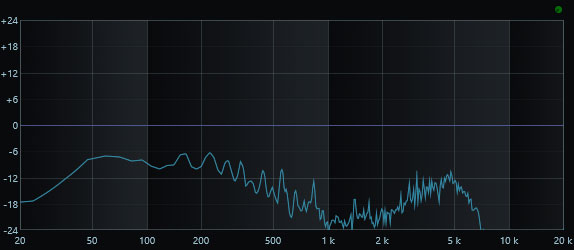
…and the “Original vs Orchid” result produces a waveform that looks like this:
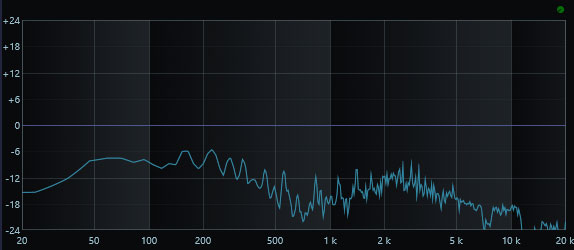
Similar, but with notable differences, not least that the Behringer seems to have done a much better job of preserving everything above 7 KHz (ish), and is also more truthful around the 1-2 KHz region.
However, as previously acknowledged, this test is crude and fails to take into consideration the behaviour of the mic preamp and interface when met with such a discrepancy in input signal. It wouldn’t be a bad working hypothesis that the Behringer, with its output transformer and lower output impedance, offers a “truer” representation of its source signal, but more extensive work would be required to actually verify this.
In any case, such hypothetical beard stroking is to some degree academic, because, in reality, if the difference can’t be reliably heard by the human ear then it doesn’t matter anyway. And that’s the crux – can we actually hear the difference? It’s very hard to say. Psychological tricks and cognitive biases abound when comparing audio signals in this fashion. When comparing these two DI boxes, my good friend was utterly convinced that he could hear a special something in his one. As in, the one that he paid for. It’s not difficult to speculate why. And so to me this kind of thing isn’t really a story about the fidelity of audio devices, academically ponderous though that is, but one of human psychology and the innate peculiarities of our reasoning, which push us away from truth and unwittingly in the direction of confirmation bias, expectation bias, belief bias, the bandwagon effect, the backfire effect, the ostrich effect, Semmelweis reflex or subjective validation. We are flawed, fallible and fragile, and it is these tendencies that hold greater sway over our decision making than the imperceptible micro-differences between similar objects. There may be a small difference between these two DI boxes when examined under a microscope, but ultimately, who actually gives a shit? They both behave perfectly reasonably, and the moment that is not the case the vital difference will become obvious. If the difference we’re encouraged to be worried about is significantly less than the difference incurred by the smallest tweak of an instrument’s tone dial, I’m not sure it’s a difference I can be bothered to care about.
The only other point of interest with regards to these two DI boxes that up until just now I had forgotten to mention was the noise floor, so let me just shine a dim light on that with these images, which show the noise floor in each instance, with nothing plugged in to the DI boxes, and with the level increased by 48dB after recording within my DAW:
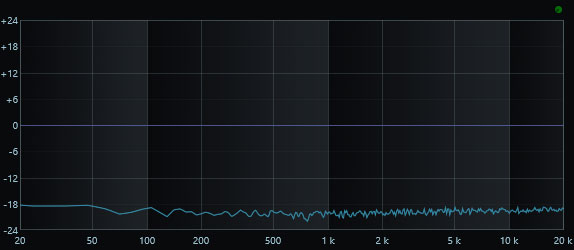
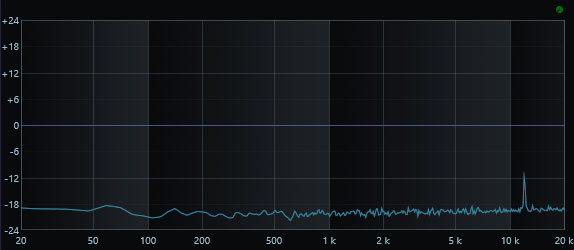
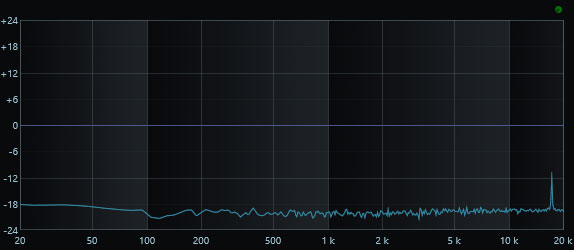
Essentially we find here that there is no noteworthy increase in aggregate noise imparted by either of the two DI boxes on trial, yet with the curious addition of a small spike around the 11.8KHz mark on the Behringer, and 17KHz on the Orchid. In both cases this is due to phantom power, demonstrable by the fact that, when switched off and run on battery power, the spike disappeared. Perhaps an electronics engineer can tell me why this might be the case, but for now I’m not sure I care much about a -50dB spike at an almost inaudible frequency.
I think the last thing I’ll say before closing down my computer and going to bed (given how profoundly boring I am now finding this topic to be), is that, given my conviction that the only thing that matters is what we can actually hear, a very good way to discern any difference between two sources is to loop a tiny fragment of audio and allow the harmonic peculiarities of that small repetition to firmly embed themselves in your senses. Apart from being an almost hypnotic experience, it is useful to see if we can actually detect any real difference from a single moment of audio. And so that is what I have done. I invite you, readers, to listen to these repetitions. Hidden in there, somewhere, are spontaneous flips between source signal, no DI, Behringer and Orchid recordings. I won’t say where they occur – they could be all bunched up at the end, evenly distributed throughout, or none of the above, but they are all there in a non-specific order. Your job is to listen out for the changes. See if you can spot them, and if you can, relay which is which. When are you listening to the original file and when are you listening to it recorded through the kind of Behringer DI box that “experienced” audiophiles might look down their noses at? Can you tell? Let me know.
I’m all ears.
Repetition 1
Repetition 2


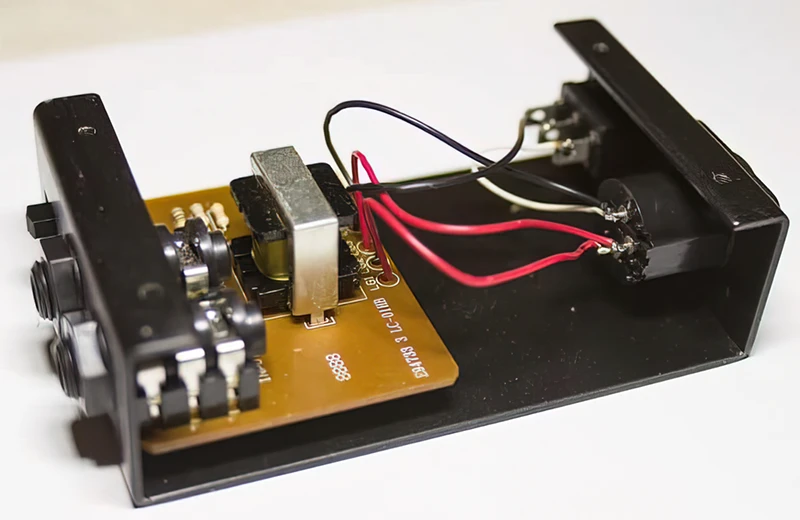



One Response
I was sent looking for answers on this subject after watching the gear section towards the end of https://www.youtube.com/watch?v=nKqfCZ8WMSQ, when, Adrian, at all other times a perfectly sane seeming guy, plugs into a DI box which I was astonished to discover is possibly £350 worth of kit.
Thanks the most useful bs free thing I’ve come across on this subject, and, now that I’ve read this, I’ll probably not bother buying one at all but just plug stuff straight into my audio interface. If I do buy one I’ll buy a cheapish one. That said, I was sceptical to begin so, like you say probably confirmation bias, but, in this case that’s the cheaper choice and I’m happy with that 🙂
This, https://www.youtube.com/watch?v=gwHR-wONYMc, is particular is eye rolling dumb. They are all high end units. It might have been more useful to compare them with some cheaper ones, but, that may have given the game away even more than this does, i.e. that all the high end ones sound basically the same as each other and that all the low end ones pretty much would have too!